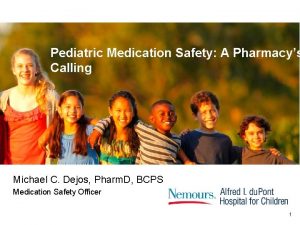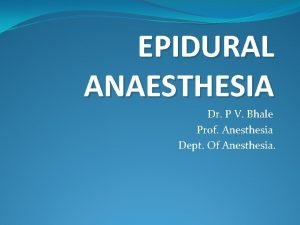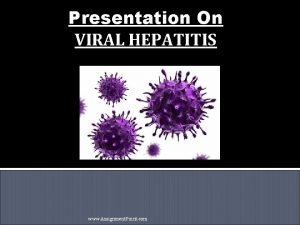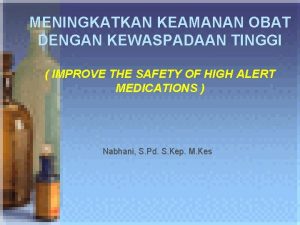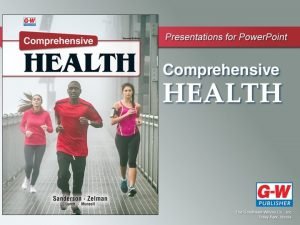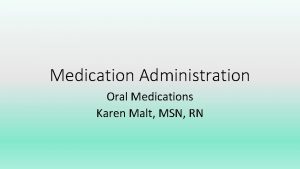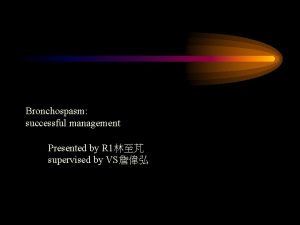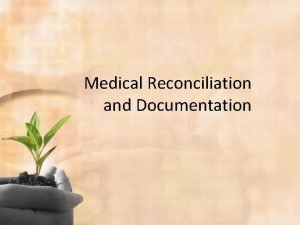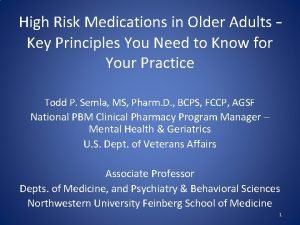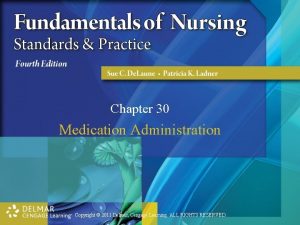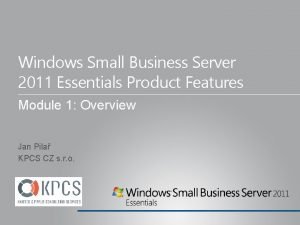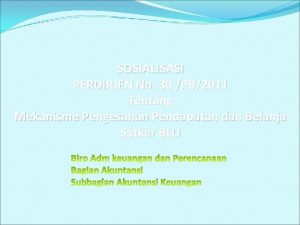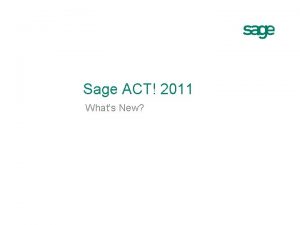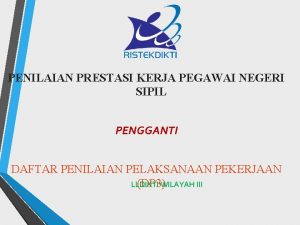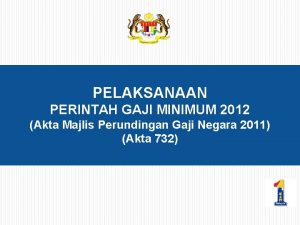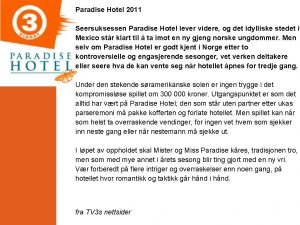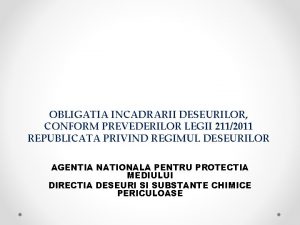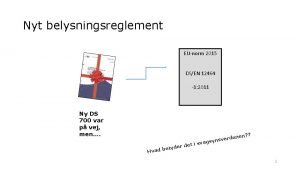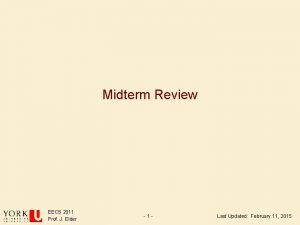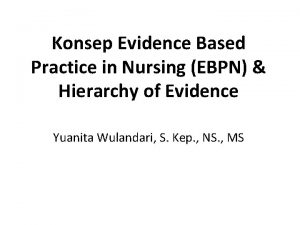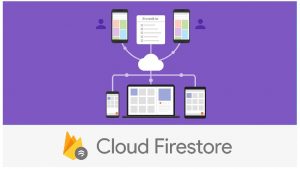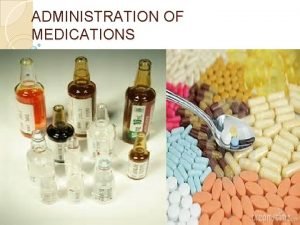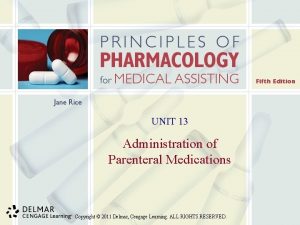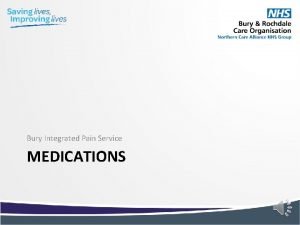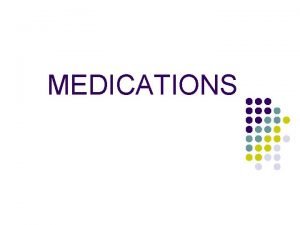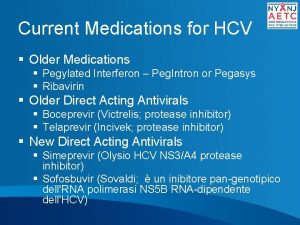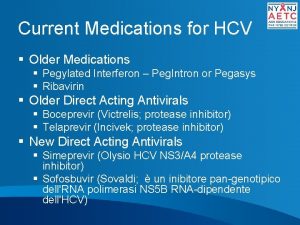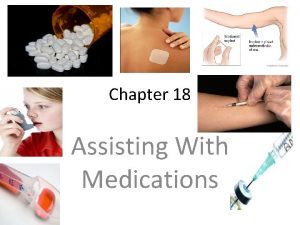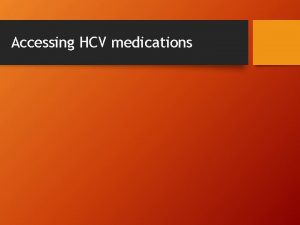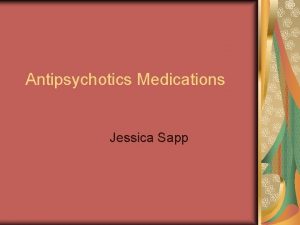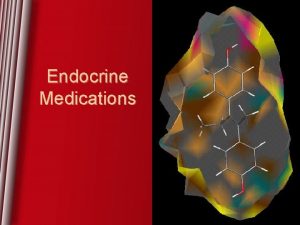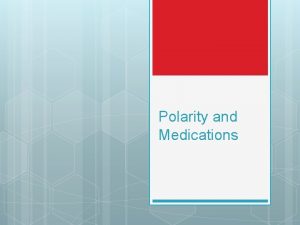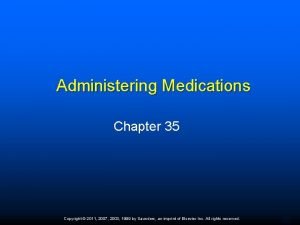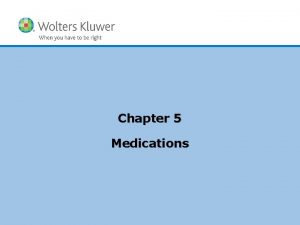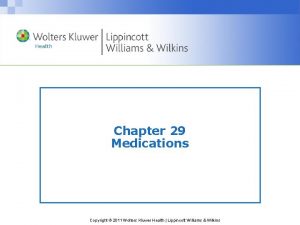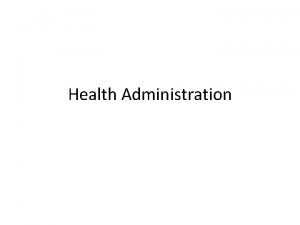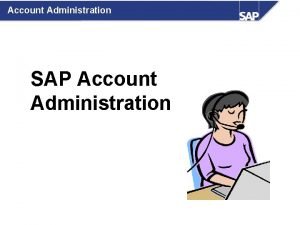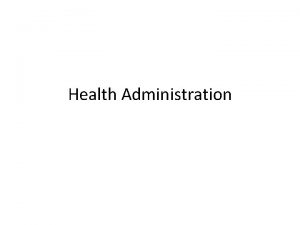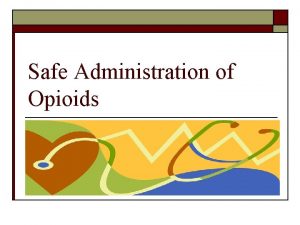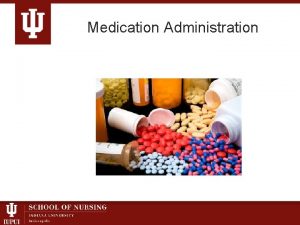UNIT 11 Administration of Nonparenteral Medications Copyright 2011














































- Slides: 46

UNIT 11 Administration of Nonparenteral Medications Copyright © 2011 Delmar, Cengage Learning. ALL RIGHTS RESERVED.

Key Terms • • Angina pectoris Canthus Enema Hypoxemia Inhalation Inhaler Insertion Instillation • • Inunction Irrigation Nitroglycerin Ointment Oxygen Suppository Transdermal system Copyright © 2011 Delmar, Cengage Learning. ALL RIGHTS RESERVED.

Nonparenteral Medications • • Oral Ophthalmic/otic Nasal Rectal • • Special delivery Inhalation Oxygen Local application Copyright © 2011 Delmar, Cengage Learning. ALL RIGHTS RESERVED.

Oral Medications • Advantages – Economical – Safest – Most convenient (continues) Copyright © 2011 Delmar, Cengage Learning. ALL RIGHTS RESERVED.

Oral Medications • Disadvantages – – – – Bad taste or smell Discoloration of teeth, gums, or tongue Irritation to stomach Altered by digestive enzymes Poor absorption/less predictable Difficult to take because of nausea/vomiting May be refused by patient Copyright © 2011 Delmar, Cengage Learning. ALL RIGHTS RESERVED.

Equipment and Supplies • • • Medicine cup Tablet crusher Medicine dropper Drinking straws Water cup Syringe Copyright © 2011 Delmar, Cengage Learning. ALL RIGHTS RESERVED.

Multiple-Dose Solid Medication Administration • • • Remove cap, touching only outside Dispense into cap Transfer to paper cup Recap container Dispense one medication at a time Copyright © 2011 Delmar, Cengage Learning. ALL RIGHTS RESERVED.

Multiple-Dose Liquid Medication Administration • • Shake if necessary Remove cap; place face up on flat surface Cover label with palm of hand Pour at eye level; measure lowest point of meniscus • Do not touch bottle to cup • Cleanse bottle; recap Copyright © 2011 Delmar, Cengage Learning. ALL RIGHTS RESERVED.

Unit-Dose Medication Administration • Open at the patient’s side – If refused, medication is not wasted • Without touching medication, place in patient’s hand or medicine cup • If necessary to bisect tablet, do so before entering patient room Copyright © 2011 Delmar, Cengage Learning. ALL RIGHTS RESERVED.

Crushing Medications • Ensure medication may be safely crushed – Time-released, buccal, sublingual, enteric-coated tablets cannot be crushed • Tablet crusher or mortar and pestle work best • May sometimes mix medication in food • Ensure all medication is taken Copyright © 2011 Delmar, Cengage Learning. ALL RIGHTS RESERVED.

Oral Medication Safety Precautions • • • Observe for reactions Check medication label (third time) Discard disposable materials Return unused supplies to storage Clean and return reusable materials Wash hands (continues) Copyright © 2011 Delmar, Cengage Learning. ALL RIGHTS RESERVED.

Oral Medication Safety Precautions Discussion Questions: Under what circumstances might you have to crush medications? What types of medications should not be crushed? What should you do if the label on a bottle of liquid medication becomes soiled? Copyright © 2011 Delmar, Cengage Learning. ALL RIGHTS RESERVED.

Ophthalmic Medication Administration • Instillation – Eye drops or solutions • Application – Ointments Warning! Ophthalmic medications are meant to have a local effect, but if not administered properly, may be absorbed systemically. Copyright © 2011 Delmar, Cengage Learning. ALL RIGHTS RESERVED.

Eye Instillations • • Wash hands and put on gloves Assemble supplies and prepare patient Have patient look up to ceiling Place drops in center of lower conjunctival sac • Do not touch eye with dropper (continues) Copyright © 2011 Delmar, Cengage Learning. ALL RIGHTS RESERVED.

Eye Instillations • Have patient close eye and roll eyeball to distribute medication • Blot excess from eyelids with cotton ball • Dispose of supplies • Wash hands • Document procedure Copyright © 2011 Delmar, Cengage Learning. ALL RIGHTS RESERVED.

Eye Applications • • Wash hands and put on gloves Assemble supplies and prepare patient Have patient look up to ceiling Place hand in which you are holding ointment against patient’s forehead • Place medication along conjunctival border, starting at inner canthus, moving toward outer canthus (continues) Copyright © 2011 Delmar, Cengage Learning. ALL RIGHTS RESERVED.

Eye Applications • Have patient close eye and roll eyeball to distribute medication • Blot excess from eyelids with sterile gauze pad • Instruct patient to not rub eyes and to remain supine for 5 minutes • Dispose of supplies and wash hands • Document Copyright © 2011 Delmar, Cengage Learning. ALL RIGHTS RESERVED.

Otic Medication Administration • Usually administered by instillation • Uses – – – Treat infection Reduce inflammation Soften cerumen Localize anesthetic effect Immobilize trapped insect (continues) Copyright © 2011 Delmar, Cengage Learning. ALL RIGHTS RESERVED.

Otic Medication Administration • Contraindications – – Perforated eardrum Hypersensitivity Herpes or other viral infections Systemic fungal infections (continues) Copyright © 2011 Delmar, Cengage Learning. ALL RIGHTS RESERVED.

Otic Medication Administration Discussion Questions: Why would you not instill otic medications for a patient with herpes? Why would you not instill otic medications for a patient with a perforated eardrum? Copyright © 2011 Delmar, Cengage Learning. ALL RIGHTS RESERVED.

Ear Instillation • • • Wash hands and put on gloves Assemble supplies and prepare patient Adult: pull top of ear upward and back Child: pull earlobe downward and back Instill medication (continues) Copyright © 2011 Delmar, Cengage Learning. ALL RIGHTS RESERVED.

Ear Instillation • Have patient remain in position for approximately 5 minutes • If instructed by physician, insert moistened cotton ball for 15 minutes • Dispose of supplies • Wash hands • Document procedure Copyright © 2011 Delmar, Cengage Learning. ALL RIGHTS RESERVED.

Nasal Medication Administration • • Instillation Spray Nasal inhaler Uses – Relief of nasal congestion – Rhinitis (continues) Copyright © 2011 Delmar, Cengage Learning. ALL RIGHTS RESERVED.

Nasal Medication Administration • Contraindicated if hypersensitive • Long-term use of nasal decongestants may cause rebound effect • Best administered by patient • Instruct patient to clear nasal passages prior to use (continues) Copyright © 2011 Delmar, Cengage Learning. ALL RIGHTS RESERVED.

Nasal Medication Administration Discussion Question: What is meant by “rebound effect”? Copyright © 2011 Delmar, Cengage Learning. ALL RIGHTS RESERVED.

Rectal Medication Administration • Suppositories • Ointments • Enemas Discussion Question: Why should laxatives or enemas be avoided for anyone with undiagnosed abdominal pain? Copyright © 2011 Delmar, Cengage Learning. ALL RIGHTS RESERVED.

Rectal Medication Uses • Suppositories – – – Laxatives Anti-inflammatory Anesthetic Antipyretic Analgesics Antiemetics • Ointments – Anti-inflammatory – Shrink hemorrhoidal tissues (continues) Copyright © 2011 Delmar, Cengage Learning. ALL RIGHTS RESERVED.

Rectal Medication Uses • Enemas – Laxatives – Bowel prep for surgery or diagnostic testing Warning! Enemas should never be given to children under the age of 2 or to patients with undiagnosed abdominal pain. Enema or suppository use may cause a vagal response, which may slow or stop the heart. Copyright © 2011 Delmar, Cengage Learning. ALL RIGHTS RESERVED.

Transdermal Medications • Patches consisting of four layers • Medical assistant must always wear gloves when applying transdermal medications • Remember to remove previous patch before placing a new one on the patient’s skin Copyright © 2011 Delmar, Cengage Learning. ALL RIGHTS RESERVED.

Inhaled Medication Administration • Local treatment for respiratory tract infections • Systemic treatment for serious respiratory infections • Supply medication that can be absorbed into the bloodstream through the lungs Copyright © 2011 Delmar, Cengage Learning. ALL RIGHTS RESERVED.

Inhalers • • Handheld Metered-dose inhaler (MDI) Nebulizer IPPB machines (continues) Copyright © 2011 Delmar, Cengage Learning. ALL RIGHTS RESERVED.

Inhalers • Considerations – – – Follow physician’s orders Avoid overuse Use only for labeled number of uses Notify physician if prescribed dose is ineffective Perform good oral hygiene (continues) Copyright © 2011 Delmar, Cengage Learning. ALL RIGHTS RESERVED.

Inhalers • Contraindications – – Delicate fluid balance Cardiac arrhythmias Status asthmaticus Hypersensitivity (continues) Copyright © 2011 Delmar, Cengage Learning. ALL RIGHTS RESERVED.

Inhalers Discussion Questions: What would happen if a patient used an inhaler for more than the labeled number of actuations? What could happen with overuse of an inhaler? Copyright © 2011 Delmar, Cengage Learning. ALL RIGHTS RESERVED.

Oxygen Administration • • Colorless Odorless Tasteless Essential for life (continues) Copyright © 2011 Delmar, Cengage Learning. ALL RIGHTS RESERVED.

Oxygen Administration • Facts – – Normal adult range, arterial blood: 80– 100 mm Hg Must be prescribed by physician Dosage based on individual needs Ordered as LPM or % Copyright © 2011 Delmar, Cengage Learning. ALL RIGHTS RESERVED.

Hypoxemia • Deficient amount of oxygen in blood • Symptoms – – Anxiety, restlessness, confusion Cyanosis; pale, cold extremities Dyspnea Increased BP and pulse Copyright © 2011 Delmar, Cengage Learning. ALL RIGHTS RESERVED.

Oxygen Toxicity • May develop when 100% oxygen is breathed for prolonged period • Depends on dose, time, and patient response • May cause alveolar collapse, hemorrhage, CNS disturbance (continues) Copyright © 2011 Delmar, Cengage Learning. ALL RIGHTS RESERVED.

Oxygen Toxicity • Symptoms – – – Substernal pain Nausea/vomiting Malaise/fatigue Numbness Tingling of extremities Copyright © 2011 Delmar, Cengage Learning. ALL RIGHTS RESERVED.

Oxygen Delivery Methods • Nasal cannulas – Simplest and most convenient – Lower concentrations • Masks – Types: disposable, partial rebreather, nonrebreather, Venturi – Higher concentrations – More humidity (continues) Copyright © 2011 Delmar, Cengage Learning. ALL RIGHTS RESERVED.

Oxygen Delivery Methods Warning! Extreme caution should be used when administering oxygen to patients with COPD, particularly emphysema. Flow rates greater than 2 LPM may result in apnea for patients with emphysema. Copyright © 2011 Delmar, Cengage Learning. ALL RIGHTS RESERVED.

Oxygen Considerations • Oxygen must be humidified prior to administration • Avoid direct flow of oxygen against nasal mucosa • Ensure proper fit of cannula or mask Copyright © 2011 Delmar, Cengage Learning. ALL RIGHTS RESERVED.

Oxygen Safety • NO SMOKING: oxygen supports combustion • Avoid use of small electrical appliances • Electrical medical equipment should be used with extreme caution • Explain precautions to patient and family (continues) Copyright © 2011 Delmar, Cengage Learning. ALL RIGHTS RESERVED.

Oxygen Safety Discussion Questions: Is smoking acceptable if the oxygen tank is turned off? What fabrics should patients be discouraged from wearing if using oxygen? Copyright © 2011 Delmar, Cengage Learning. ALL RIGHTS RESERVED.

Locally Applied Drugs • • • Ointments Lotions Liniments Wet dressings Poultices Plasters Copyright © 2011 Delmar, Cengage Learning. ALL RIGHTS RESERVED.

Applications to Body Cavities • Irrigation – Flushing mucous lining with solution • Instillation – Temporary retention of liquid drug • Insertion – Suppository or oral tablet Copyright © 2011 Delmar, Cengage Learning. ALL RIGHTS RESERVED.
 Non parenteral route of drug administration
Non parenteral route of drug administration Common pediatric medications
Common pediatric medications Tuohy needle sizes
Tuohy needle sizes Hepatitis d
Hepatitis d List of high-alert medications jci
List of high-alert medications jci Chapter 11 medications and drugs
Chapter 11 medications and drugs Mock code medications
Mock code medications The nurse has obtained the patient's oral medications
The nurse has obtained the patient's oral medications Mobile dispensing unit & drug basket are methods of
Mobile dispensing unit & drug basket are methods of Chapter 30 administering medications
Chapter 30 administering medications Medications
Medications Sick day medications
Sick day medications Reconciliation medical definition
Reconciliation medical definition High risk medications
High risk medications Chapter 30 administering medications
Chapter 30 administering medications Migranal
Migranal Economic protest parties definition
Economic protest parties definition Unit 10, unit 10 review tests, unit 10 general test
Unit 10, unit 10 review tests, unit 10 general test Wyd 2011 madrid
Wyd 2011 madrid Small business server 2010
Small business server 2010 Windows small business server 2011 essentials
Windows small business server 2011 essentials Goals of communication by seitel
Goals of communication by seitel Uma equipe de cientistas lançará
Uma equipe de cientistas lançará Per-30/pb/2011
Per-30/pb/2011 Yevarejeja yahweh
Yevarejeja yahweh Alexis serial
Alexis serial Sage act 2011
Sage act 2011 Chemistry regents 2011
Chemistry regents 2011 2011-1989
2011-1989 There names
There names Perfil de egreso de primer grado de primaria pdf
Perfil de egreso de primer grado de primaria pdf Pergub 140 tahun 2011
Pergub 140 tahun 2011 Perbedaan pp 46 tahun 2011 dengan pp 30 tahun 2019
Perbedaan pp 46 tahun 2011 dengan pp 30 tahun 2019 Usa infotehnoloog 1955-2011
Usa infotehnoloog 1955-2011 Perintah gaji minimum 2012
Perintah gaji minimum 2012 Paradise hotel 2011
Paradise hotel 2011 Legea 211 2011
Legea 211 2011 En 12464-1:2011
En 12464-1:2011 National population and housing census 2011
National population and housing census 2011 Eecs2011
Eecs2011 Unieważnienie matury 2011
Unieważnienie matury 2011 Lloyds open form
Lloyds open form How can you import your movie assets to wlmm
How can you import your movie assets to wlmm How can you import your movie assets to wlmm?
How can you import your movie assets to wlmm? Ebpn adalah
Ebpn adalah Hpec 2011
Hpec 2011 Firebase history
Firebase history

